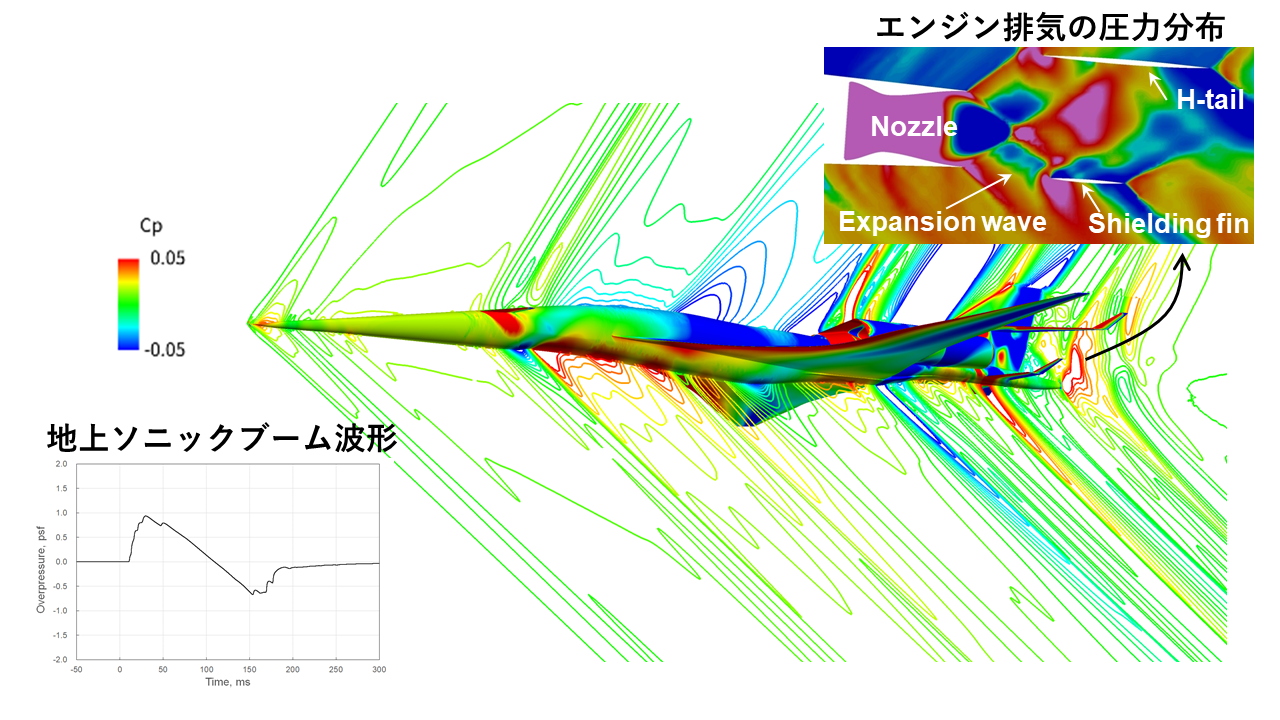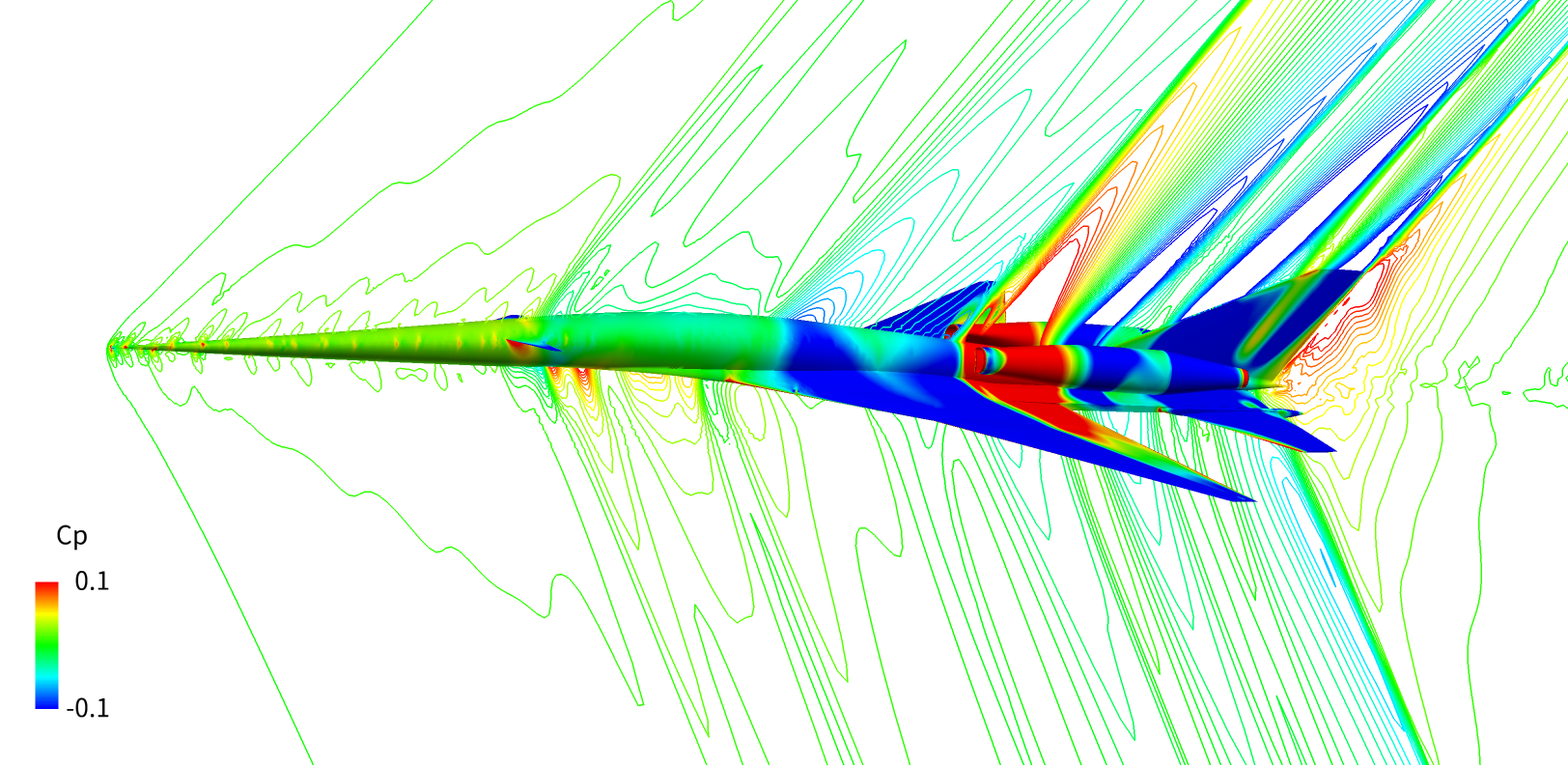Research and development for system integration of silent supersonic airplane technologies
JAXA Supercomputer System Annual Report February 2021-January 2022
Report Number: R21EA3800
Subject Category: Aeronautical Technology
- Responsible Representative: Yoshikazu Makino, Aviation Technology Directorate, Silence Supersonic Aircraft Team
- Contact Information: Hiroaki Ishikawa(ishikawa.hiroaki2@jaxa.jp)
- Members: Junichi Akatsuka, Hirokazu Higashida, Hiroaki Ishikawa, Shinya Koganezawa, Masashi Kanamori, Satoshi Kondo, Ryo Shimada, Hajime Miki, Yusuke Naka, Hideji Saiki, Kohmi Takahashi, Naoko Tokugawa, Hisato Takeda, Yoshine Ueda, Atsushi Ueno, Tatsunori Yuhara, Rei Yamashita
Abstract
It is important to acquire world-class high level technology in order to enhance the international competitiveness of Japan’s aircraft manufacturing industry, especially for supersonic transport. In addition, the advantage is great, such as revitalizing economic activities from the business and tourism aspects by shortening the travel time of supersonic flight, and the health aspects of passengers such as suppression of economy class syndrome. Based on this, the purpose of this project is to acquire the key technologies required to realize a “quiet supersonic aircraft” and contribute to the development of the aircraft manufacturing industry and air transport in the future. In this project, R&D on sonic boom estimation, measurement and evaluation technologies will contribute to the formulation of international standards at ICAO required for over land supersonic flight. The integrated design technology that simultaneously satisfies both low boom, low drag, low noise and weight reduction are developed to present a concept of a supersonic transport that simultaneously satisfies these technical goals.
Reference URL
Please refer to https://www.aero.jaxa.jp/eng/research/frontier/sst/ .
Reasons and benefits of using JAXA Supercomputer System
To develop a future supersonic transport that satisfies the requirement of low sonic-boom and low aerodynamic drag, it is necessary to estimate aerodynamic properties and sonic-boom properties by accurate numerical simulation. JSS is used to estimate aerodynamic performances of various configurations with high accuracy and high efficiency for the designing of the low-boom supersonic transport.
Achievements of the Year
Sonic boom loudness reduction and improving fuel efficiency by aerodynamic drag reduction are essential issues for the realization of future supersonic transport. A numerical design method to reduce the sonic boom loudness generated during supersonic flight, not only on the under-track ground below the aircraft, but also on the side region (off-track), has been developed. At the same time, a natural laminar flow wing design was applied to reduce aerodynamic drag and their effectiveness are demonstrated (Fig.1). In particular, in order to clarify the effect of the natural laminar flow wing design method, the developed method is applied to a supersonic aircraft of different scales, and its effectiveness is shown in this study (Fig.2).
Publications
– Peer-reviewed papers
Ishikawa, H., Koganezawa, S. and Makino, Y., “Unstructured/Structured Overset Grid Simulation for the Third AIAA Sonic Boom Prediction Workshop,” AIAA Journal of Aircraft, 2021 (published Online on 17 Aub. 2021) doi.org/10.2514/1.C03638
Rei Yamashita, Yoshikazu Makino, Philip L. Roe: Fast Full-Field Simulation of Sonic Boom Using a Space Marching Method, AIAA J., 2022 (published Online on 11 Feb 2022). doi: 10.2514/1.J061363
Kanamori, M., Ishikawa, H., Naka, Y. and Makino, Y., “Numerical Simulation of Diffracted U-Shaped Sonic Boom Waveform,”
AIAA Journal, AIAA, doi.org/10.2514/1.J060477
– Oral Presentations
Rei Yamashita, Yoshikazu Makino, Philip L. Roe: Fast Full-Field Simulation of Sonic Boom Using Space Marching Method, AIAA Paper 2021-2618, AIAA AVIATION 2021 Forum, Virtual Event, August 2–6, 2021. doi: 10.2514/6.2021-2618
Usage of JSS
Computational Information
- Process Parallelization Methods: MPI
- Thread Parallelization Methods: Automatic Parallelization
- Number of Processes: 128 – 512
- Elapsed Time per Case: 20000 Second(s)
JSS3 Resources Used
Fraction of Usage in Total Resources*1(%): 1.33
Details
Please refer to System Configuration of JSS3 for the system configuration and major specifications of JSS3.
| System Name | CPU Resources Used(Core x Hours) | Fraction of Usage*2(%) |
|---|---|---|
| TOKI-SORA | 24694233.49 | 1.20 |
| TOKI-ST | 344976.90 | 0.42 |
| TOKI-GP | 35599.57 | 23.65 |
| TOKI-XM | 46895.51 | 33.79 |
| TOKI-LM | 174076.72 | 12.98 |
| TOKI-TST | 0.00 | 0.00 |
| TOKI-TGP | 0.00 | 0.00 |
| TOKI-TLM | 0.00 | 0.00 |
| File System Name | Storage Assigned(GiB) | Fraction of Usage*2(%) |
|---|---|---|
| /home | 912.16 | 0.91 |
| /data and /data2 | 69740.24 | 0.75 |
| /ssd | 754.17 | 0.19 |
| Archiver Name | Storage Used(TiB) | Fraction of Usage*2(%) |
|---|---|---|
| J-SPACE | 26.06 | 0.18 |
*1: Fraction of Usage in Total Resources: Weighted average of three resource types (Computing, File System, and Archiver).
*2: Fraction of Usage:Percentage of usage relative to each resource used in one year.
ISV Software Licenses Used
| ISV Software Licenses Used(Hours) | Fraction of Usage*2(%) | |
|---|---|---|
| ISV Software Licenses(Total) | 8616.81 | 6.04 |
*2: Fraction of Usage:Percentage of usage relative to each resource used in one year.
JAXA Supercomputer System Annual Report February 2021-January 2022




